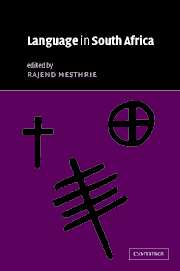Book contents
- Frontmatter
- Contents
- List of maps
- List of contributors
- Acknowledgements
- List of phonetic symbols
- List of abbreviations
- Introduction
- Part I The main language groupings
- 1 South Africa: a sociolinguistic overview
- 2 The Khoesan Languages
- 3 The Bantu languages: sociohistorical perspectives
- 4 Afrikaans: considering origins
- 5 South African English
- 6 South African Sign Language: one language or many?
- 7 German speakers in South Africa
- 8 Language change, survival, decline: Indian languages in South Africa
- Part II Language contact
- Part III Language planning, policy and education
- Index
- References
7 - German speakers in South Africa
from Part I - The main language groupings
Published online by Cambridge University Press: 22 September 2009
- Frontmatter
- Contents
- List of maps
- List of contributors
- Acknowledgements
- List of phonetic symbols
- List of abbreviations
- Introduction
- Part I The main language groupings
- 1 South Africa: a sociolinguistic overview
- 2 The Khoesan Languages
- 3 The Bantu languages: sociohistorical perspectives
- 4 Afrikaans: considering origins
- 5 South African English
- 6 South African Sign Language: one language or many?
- 7 German speakers in South Africa
- 8 Language change, survival, decline: Indian languages in South Africa
- Part II Language contact
- Part III Language planning, policy and education
- Index
- References
Summary
DEMOGRAPHY AND SOCIAL HISTORY
German settlers featured prominently in white South Africa from the start of the settlement at the Cape: it is estimated that at the end of the eighteenth century more than half of the white population of the Cape was of German descent. However, until well into the nineteenth century German-speaking colonists were speedily assimilated: it was almost exclusively men who came out to the Cape, and they soon intermarried with Afrikaans-Dutch speakers and were also linguistically assimilated (Steyn 1980: 113). It was only from the mid-nineteenth century onwards that this willingness to integrate with the other settlers began to disappear. During the second half of the nineteenth century there was a continual influx of German speakers as missionaries and settlers into Natal, the eastern Cape and the south-western Transvaal, and these groups, especially in the rural areas, formed small German-speaking communities centred around a church and a school. From a linguistic point of view these immigrants were unusual in that, in spite of their status as a tiny minority within the white minority in South Africa, they succeeded in maintaining their language over a number of generations. Although the last fifty years has seen many of the original communities finally become assimilated, a number still remain, in particular in KwaZulu-Natal. In this chapter I will therefore attempt to describe aspects of the present-day distribution and usage of German, especially in KwaZulu-Natal, and to consider prospects for the future maintenance of the language.
- Type
- Chapter
- Information
- Language in South Africa , pp. 148 - 160Publisher: Cambridge University PressPrint publication year: 2002



